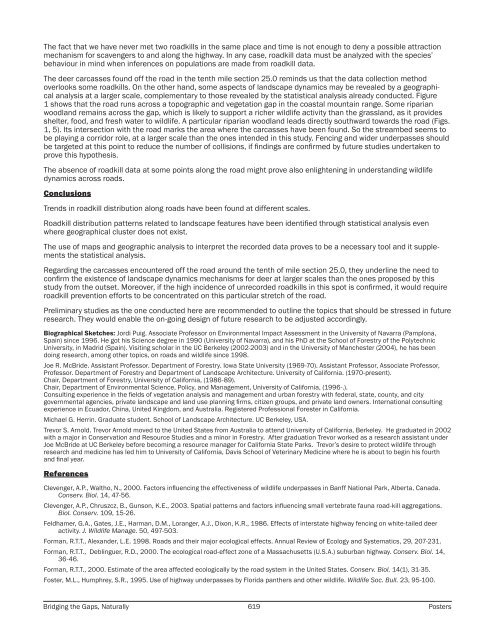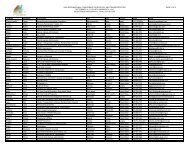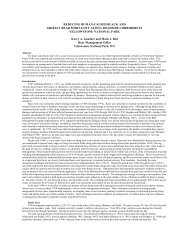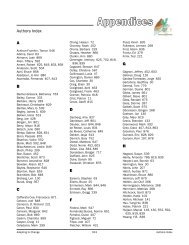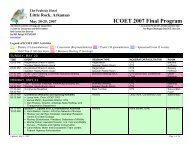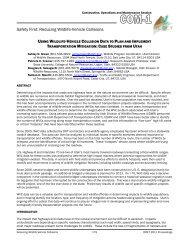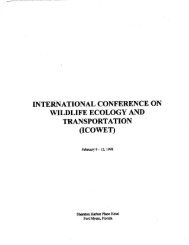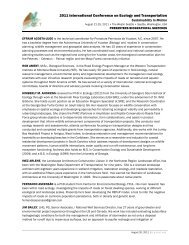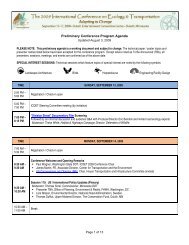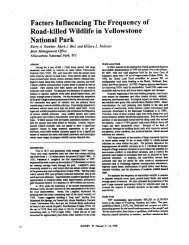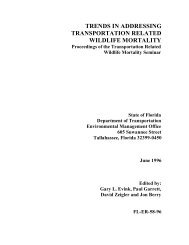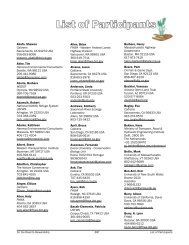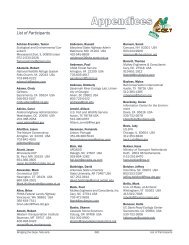Poster Sessions, pages 567-640 - ICOET
Poster Sessions, pages 567-640 - ICOET
Poster Sessions, pages 567-640 - ICOET
You also want an ePaper? Increase the reach of your titles
YUMPU automatically turns print PDFs into web optimized ePapers that Google loves.
The fact that we have never met two roadkills in the same place and time is not enough to deny a possible attraction<br />
mechanism for scavengers to and along the highway. In any case, roadkill data must be analyzed with the species’<br />
behaviour in mind when inferences on populations are made from roadkill data.<br />
The deer carcasses found off the road in the tenth mile section 25.0 reminds us that the data collection method<br />
overlooks some roadkills. On the other hand, some aspects of landscape dynamics may be revealed by a geographical<br />
analysis at a larger scale, complementary to those revealed by the statistical analysis already conducted. Figure<br />
1 shows that the road runs across a topographic and vegetation gap in the coastal mountain range. Some riparian<br />
woodland remains across the gap, which is likely to support a richer wildlife activity than the grassland, as it provides<br />
shelter, food, and fresh water to wildlife. A particular riparian woodland leads directly southward towards the road (Figs.<br />
1, 5). Its intersection with the road marks the area where the carcasses have been found. So the streambed seems to<br />
be playing a corridor role, at a larger scale than the ones intended in this study. Fencing and wider underpasses should<br />
be targeted at this point to reduce the number of collisions, if findings are confirmed by future studies undertaken to<br />
prove this hypothesis.<br />
The absence of roadkill data at some points along the road might prove also enlightening in understanding wildlife<br />
dynamics across roads.<br />
Conclusions<br />
Trends in roadkill distribution along roads have been found at different scales.<br />
Roadkill distribution patterns related to landscape features have been identified through statistical analysis even<br />
where geographical cluster does not exist.<br />
The use of maps and geographic analysis to interpret the recorded data proves to be a necessary tool and it supplements<br />
the statistical analysis.<br />
Regarding the carcasses encountered off the road around the tenth of mile section 25.0, they underline the need to<br />
confirm the existence of landscape dynamics mechanisms for deer at larger scales than the ones proposed by this<br />
study from the outset. Moreover, if the high incidence of unrecorded roadkills in this spot is confirmed, it would require<br />
roadkill prevention efforts to be concentrated on this particular stretch of the road.<br />
Preliminary studies as the one conducted here are recommended to outline the topics that should be stressed in future<br />
research. They would enable the on-going design of future research to be adjusted accordingly.<br />
Biographical Sketches: Jordi Puig. Associate Professor on Environmental Impact Assessment in the University of Navarra (Pamplona,<br />
Spain) since 1996. He got his Science degree in 1990 (University of Navarra), and his PhD at the School of Forestry of the Polytechnic<br />
University, in Madrid (Spain). Visiting scholar in the UC Berkeley (2002-2003) and in the University of Manchester (2004), he has been<br />
doing research, among other topics, on roads and wildlife since 1998.<br />
Joe R. McBride. Assistant Professor. Department of Forestry. Iowa State University (1969-70). Assistant Professor, Associate Professor,<br />
Professor. Department of Forestry and Department of Landscape Architecture. University of California. (1970-present).<br />
Chair, Department of Forestry, University of California, (1986-89).<br />
Chair, Department of Environmental Science, Policy, and Management, University of California, (1996-.).<br />
Consulting experience in the fields of vegetation analysis and management and urban forestry with federal, state, county, and city<br />
governmental agencies, private landscape and land use planning firms, citizen groups, and private land owners. International consulting<br />
experience in Ecuador, China, United Kingdom, and Australia. Registered Professional Forester in California.<br />
Michael G. Herrin. Graduate student. School of Landscape Architecture. UC Berkeley, USA.<br />
Trevor S. Arnold. Trevor Arnold moved to the United States from Australia to attend University of California, Berkeley. He graduated in 2002<br />
with a major in Conservation and Resource Studies and a minor in Forestry. After graduation Trevor worked as a research assistant under<br />
Joe McBride at UC Berkeley before becoming a resource manager for California State Parks. Trevor’s desire to protect wildlife through<br />
research and medicine has led him to University of California, Davis School of Veterinary Medicine where he is about to begin his fourth<br />
and final year.<br />
References<br />
Clevenger, A.P., Waltho, N., 2000. Factors influencing the effectiveness of wildlife underpasses in Banff National Park, Alberta, Canada.<br />
Conserv. Biol. 14, 47-56.<br />
Clevenger, A.P., Chruszcz, B., Gunson, K.E., 2003. Spatial patterns and factors influencing small vertebrate fauna road-kill aggregations.<br />
Biol. Conserv. 109, 15-26.<br />
Feldhamer, G.A., Gates, J.E., Harman, D.M., Loranger, A.J., Dixon, K.R., 1986. Effects of interstate highway fencing on white-tailed deer<br />
activity. J. Wildlife Manage. 50, 497-503.<br />
Forman, R.T.T., Alexander, L.E. 1998. Roads and their major ecological effects. Annual Review of Ecology and Systematics, 29, 207-231.<br />
Forman, R.T.T., Deblinguer, R.D., 2000. The ecological road-effect zone of a Massachusetts (U.S.A.) suburban highway. Conserv. Biol. 14,<br />
36-46.<br />
Forman, R.T.T., 2000. Estimate of the area affected ecologically by the road system in the United States. Conserv. Biol. 14(1), 31-35.<br />
Foster, M.L., Humphrey, S.R., 1995. Use of highway underpasses by Florida panthers and other wildlife. Wildlife Soc. Bull. 23, 95-100.<br />
Bridging the Gaps, Naturally 619 <strong>Poster</strong>s


